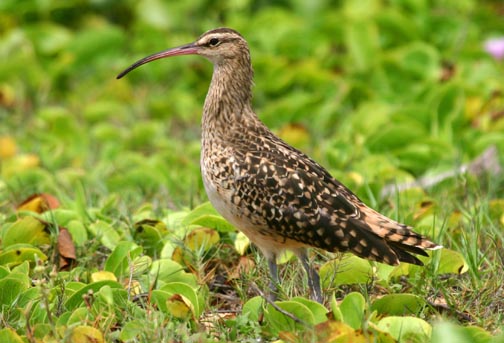Bristle-thighed Curlew (Numenius tahitiensis) - Wiki Bristle-thighed Curlew
From Wikipedia, the free encyclopedia
[Photo] Bristled thighed curlew. Source: http://www.nps.gov/kaho/KAHOckLs/curlew.htm NPS photo - Bryan Harry. Date: 27 March 2004
The Bristle-thighed Curlew, Numenius tahitiensis, is a large shore bird whose habitat ranges from Alaska to the tropical Pacific. It has a long, decurved bill and bristled feathers at the base of the legs. Plumage varies from spotted brown on their upper body to a light belly and rust colored tail. Its length is about 43 cm and wingspan about 84 cm. Their population is estimated at 7,000.
The bird is rarely seen near populated land masses, with only a handful of sightings in Canada, California and Oregon. The species was first described scientificaly during James Cook's visits to Tahiti in the 18th century, but its summer nesting grounds weren't identified until 1948.
Summer nesting grounds are on the lower Yukon River and Seward Peninsula, with the birds preferring low lying tundra near the shoreline. Nests are built in ground depressions and lined with tundra moss. Eggs are greenish with brown spots, with four to a clutch and one brood per season. Incubation lasts 25 days, with both parents tending the nest and protecting the newly hatched chicks. They feed on a wide variety of vegetation, insects, sea life, and other bird's eggs, for which they use rocks as tools to break open.
Adults leave their chicks at about five weeks of age to migrate south. The chicks continue to feed until they are able to make the journey. The first leg of migration includes a nonstop 4,000 km flight from Alaska to Laysan. They are able to make non-stop flights in excess of 6,000 km.
Bristle-thighed Curlews are somewhat unique compared to other shore birds in that they are flightless during molt. Also, their migration departures consist of small flocks and have no diurnal patterns.
Its winter habitat is tropical Oceania, and includes Micronesia, Fiji, Tonga, Hawaiian Islands, Samoa, and French Polynesia. There is concern over encroachment and introduced predators in their winter habitat.
http://en.wikipedia.org/wiki/Bristle-thighed_Curlew
| The text in this page is based on the copyrighted Wikipedia article shown in above URL. It is used under the GNU Free Documentation License. You may redistribute it, verbatim or modified, providing that you comply with the terms of the GFDL. |
